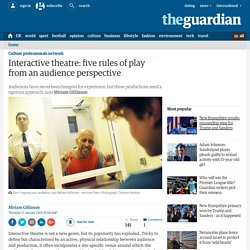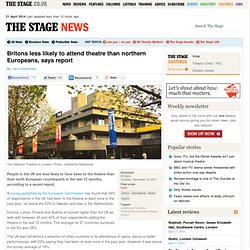

Immersive Theatre. Immersive Theatre is all about creating participative theatre experiences in which audience members give up their “observer’’ status to become co-actors and co-creators of the narrative and of the storytelling process.

Our audience members are action wise performers who direct the story by taking decisions, choosing from infinite options and negotiating the process.Audience is the storyteller! Audience will be inside the space, walking through site-specific installations, choosing what scenes to see, changing and elaborating the text, creating movements and physically responding to actions to create site-responsive theatre. The performance will never be the same. Combining text, movement, video, objects, sound, lights and visuals, we aim for a ‘total experience’, for ‘transportation performances’ that result in rendering powerful emotions and eye-opening adventures.
Sensory experience. Retail theatre. Interactive theatre: five rules of play from an audience perspective. Interactive theatre is not a new genre, but its popularity has exploded.

Tricky to define but characterised by an active, physical relationship between audience and production, it often incorporates a site-specific venue around which the audience is free to roam. Shunt, arguably the daddy of this genre, has inspired countless other companies, all wrestling for space on the fringe. Done well, interactive theatre is extraordinary: engaging, exhilarating and transcendent. All too often, however, so-called 'interactive' shows are sloppy and ineffective.
They feel loose – anarchic even – when they actually demand a rigorous approach. With this in mind here are five rules for interactive theatre from an audience perspective, based on my own experiences at a range of shows. Think outside your venue Site-specific venues range from reclaimed spaces to venues constructed entirely from scratch or the great outdoors. Justify your audience / actor ratio Enclose audiences, don't expose them Be consistent. E is for experiment.
Experimental theatre is a hard concept to get one's head around, since everyone defines it differently.

It wasn't always so. For much of the 20th century, naturalism was the dominant mode. Hence the rise of a number of radical alternatives: at different times people pinned their faith in expressionism, symbolism, absurdism and Theatre of Cruelty. Today, however, we live in a world where there is no consensus about what constitutes an act of theatre and where avant garde directors such as Robert Wilson and Julie Taymor have been sucked into the mainstream. So what exactly is the role of experimental theatre in our contemporary free-for-all? In Britain, it is possible to pick out certain key trends.
Experiment is everywhere. What I'd like to see in experimental theatre is more radical purpose and aesthetic rigour. I admit that I am most drawn, as spectator and critic, to those traditional things called plays. 2013-01-29-SOLT 2012-box-office-figures.pdf. 2010 theatre attendance table to go with graph. 2010 theatre attendance graph.
Props. Performance. Set. Lighting. War Horse sells out Festival Theatre run. HE stands 17 hands high, is the focus of the biggest show to visit the Capital in 2014, and has already taken in excess of £2 million at the Festival Theatre box office – just don’t call Joey a puppet.

Joey is real, insist his producers. The star of the National Theatre’s smash-hit production of War Horse, which has now officially sold out its 31 performances at the Festival Theatre, never travels without a team of minders, in his very own ‘horse box’ and even has a storage area known as his ‘stable’. Made of metal, cane, elastic and bicycle cables, the horse may be a feat of engineering but his handlers are charged with ensuring he is never seen as just his component parts, so as not to break the illusion. Matthew Forbes, puppetry director, explained: “Joey is brought to life by three puppeteers – a Head, Heart and Hind – each with their own unique responsibilities.
Mr Forbes said: “If the puppeteer is doing their job properly they almost become invisible. Inspiration for solution. Quirky Theatre Trending. LiveAnalytics_State_of_play_TheatreUK_Low_Res. Britons less likely to attend theatre than northern Europeans, says report : News. The National Theatre in London.

Photo: Catherine Gerbrands People in the UK are less likely to have been to the theatre than their north European counterparts in the last 12 months, according to a recent report. A survey published by the European Commission has found that 39% of respondents in the UK had been to the theatre at least once in the past year, far below the 53% in Sweden and also in the Netherlands. Estonia, Latvia, Finland and Austria all scored higher than the UK as well, with between 40 and 45% of their respondents visiting the theatre in the last 12 months.
The average for 27 countries surveyed in the EU was 28%. The UK also fell behind a selection of other countries in its attendance of opera, dance or ballet performances, with 22% saying they had been at least once in the past year. Again, Swedish respondents were found to be the most likely Europeans to go to this type of performance, with 34% saying they had been in the past year.